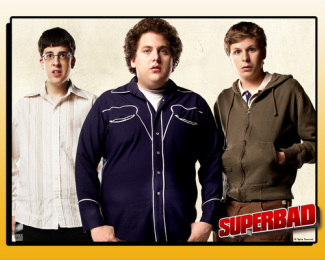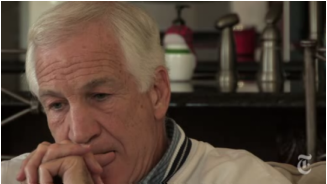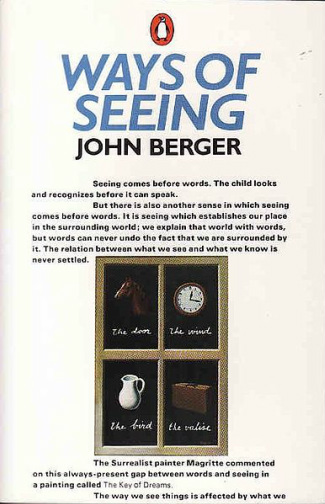 _Tags: bodies, consumption/consumerism, gender, health/medicine, knowledge, political economy, biopolitics, feminism, medicalization, menarche, menstruation, menses, patriarchy, stigma, taboo, 00 to 05 mins Year: 2007 Length: 3:57 Access: YouTube Summary: In this scene from the movie Superbad, Seth finds himself dancing close to a woman at a party and winds up with her menstrual blood on his pant leg. A group of boys at the party spot the blood and deduce the source, and thus begins one of the film's signature gags: an awkward adolescent deals with what is supposed to be an awkward adolescent moment. In addition to Seth's panicked yet futile attempts to stave off humiliation are his efforts to work through the disgust of this unambiguous contamination. "Someone period-ed on my fucking leg!" he cries while gagging. Feminists have long been critical of this all-too-common fear of menstrual contamination and point to its roots in patriarchy. It is an instance of re-imagining the natural human experience of menstruation as a pathology, which can only be experienced with a measure of shame and dread. But more than men simply pathologizing a distinctly feminine experience, the pervasive fear of menstruation also fuels a multibillion dollar industry, which produces and markets hundreds of products designed to manage and even suppress menstruation (e.g., Lybrel and Seasonique). In an interview (here) about her recent book, New Blood: Third Wave Feminism and the Politics of Menstruation, sociologist Chris Bobel nicely articulates the connection between menstrual anxiety and corporate profit: "The prohibition against talking about menstruation—shh…that’s dirty; that’s gross; pretend it’s not going on; just clean it up—breeds a climate where corporations, like femcare companies and pharmaceutical companies, like the makers of Lybrel and Seasonique, can develop and market products of questionable safety. They can conveniently exploit women’s body shame and self-hatred. And we see this, by the way, when it comes to birthing, breastfeeding, birth control and health care in general. The medical industrial complex depends on our ignorance and discomfort with our bodies." The clip would work nicely with Bobel's book and as a means of opening a discussion about biopolitics, and specifically, the intensity with which women's bodies are scrutinized and managed by both the state and economy. I would like to thank Aimee Koon for suggesting this clip. Submitted By: Lester Andrist
5 Comments
 Tags: capitalism, class, inequality, intersectionality, knowledge, marx/marxism, alienation, working poor, 61+ mins Year: 2009 Length: 70:00 Access: Netflix (trailer here) Summary: This film follows custodial staff at several U.S. colleges/universities, documenting the workers' daily lives on and off campus. The documentarians interview each person, attempting to understand their personal biographies, their daily experiences as a custodian, and their philosophies on life, love, religion, etc. This film can be used instructively in the following ways: 1) in a lecture on class, inequality, the working poor, or Marx's concept of alienation, 2) as a tool to highlight the experiences of people extremely close in proximity to students, as custodial staff are often ignored by undergraduates and other members of college/university campuses; this is also a great time to introduce campus-led initiatives such as the Harvard Living Wage Campaign, 3) as a tool to understand intersectionality, and how the intersecting identities of the custodial staff result in certain material inequalities, and 4) in class discussions about the social construction of knowledge, as the custodial staff offer epistemological perspectives rooted in unique social locations and life histories; the juxtaposition between the knowledge articulated by the custodial staff and the knowledge-producing institutions in which they work, as well as the quotes by well-known philosophers interwoven between segments, offers a very fruitful site for analysis. Submitted By: Beverly M. Pratt  Tags: discourse/language, inequality, knowledge, media, race/ethnicity, social mvmts/social change/resistance, genocide, media literacy, racism, representation, stereotypes, 61+ mins Year: 2009 Length: 88:00 Access: Netflix; YouTube (trailer; clip 1; clip 2; clip 3) Summary: Reel Injun explores the role Hollywood cinema has played in shaping the image of First Nations People. Starting with the silent film era, director Neil Diamond argues that "the Indian" first appeared in cinema as noble and dignified, but by the 1930s, classic westerns like, They Died with their Boots on, catalyzed the emergence of negative stereotypes. The Indian was newly imagined as treacherous, and Hollywood narratives began featuring white settler protagonists in their stagecoaches fending off attacks from the Indian hordes. Just as Indian characters in film became increasingly based on this one dimensional stereotype, native people were also losing the ability to play Indian roles. Instead, productions cast white actors, like Burt Lancaster, Charles Bronson, and Elvis Presley in Indian roles and even sprayed them with a toning agent to help them look the part. By the 1960s, films like Little Big Man, One Flew Over the Cuckoo's Nest, and later, Dances with Wolves, introduced more complicated depictions of native people; however, dominant narratives still tracked the imperiled white heroes in their proverbial stagecoaches (see also our clip "Avatar Remix and Representations of the Other"). Not until the renaissance in native cinema did films like Once we Were Warriors and Smoke Signals portray native people as fully realized human beings and protagonists in their own right. In the documentary's conclusion, Lakota activist and poet, John Trudell, suggests that there has been a sustained effort to vanquish native people through war and violence and to erase or subsume their history. Attention to how native people have been represented in film suggests too that Hollywood has played a vital role in this genocidal project through its representations of the Indian in film. These persistent depictions of the Indian as treacherous, barbaric, and peripheral have worked to strip native people of their humanity. And those who lack humanity are easier to vanquish. Note that this documentary film would work nicely with another clip on The Sociological Cinema (here) that explores issues surrounding the representation and First Nations People in cinema and takes up the question, "Who has the right to represent whom?" Submitted By: Lester Andrist  Tags: emotion/desire, knowledge, psychology/social psychology,, theory, cognitive sociology, cultural sociology, eviatar zerubavel, morality, stanley cohen, 06 to 10 mins Year: 2011 Length: 9:01 Access: New York Times Summary: "These allegations are false. I… didn't… do those things," says Jerry Sandusky in this interview with New York Times's reporter Jo Becker. Within just the last several weeks, sexual molestation allegations have been issued against former Penn State assistant football coach, Jerry Sandusky, and former Syracuse associate head basketball coach, Bernie Fine. Both men adamantly deny the charges. Former Republican presidential candidate, Herman Cain, has also been entangled in a high profile case of denial, asserting that he never engaged in sexual misconduct with four women (two have come out publicly), or had a 13 year affair with another woman. While all these men are innocent until otherwise proven guilty under the American justice system, the spectacle of it all offers a nice window through which to explore the sociology of denial. While studies of denial have traditionally been housed in the discipline of psychology, some scholars have sought to integrate sociological insights into the study of this enduring human phenomenon. Sociologists such as Stanley Cohen (States of Denial) and Eviatar Zerubavel (The Elephant in the Room: Silence and Denial in Everyday Life) offer an analysis of denial that explores how sociological factors such as human interaction, cultural meaning-making processes, and hierarchical power structures contribute to instances of denial in society. Students can be encouraged to apply these sociological insights to the current spectacles taking place, as well as reflect on the social consequences of denial and silences around wrongdoings. To see another clip from The Sociological Cinema that explores a human phenomenon typically conceived as individualistic and purely psychological from a sociological perspective, click here. Submitted By: Valerie Chepp  Viggo Mortensen reads Howard Zinn Viggo Mortensen reads Howard Zinn Tags: education, government/the state, historical sociology, knowledge, nationalism, political economy, war/military, activism, empire, howard zinn, imperialism, sociological imagination, subtitles/CC, 06 to 10 mins Year: 2008 Length: 8:35 Access: YouTube Summary: This video portrays Howard Zinn's essay "Empire or Humanity?: What the classroom didn’t teach me about the American empire" as narrated by the actor Viggo Mortensen (original essay and teaching materials posted here). It traces Zinn's own development of his sociological imagination, his miseducation in public schools, and his critique of US foreign policy. This video is good for introducing the concept of the sociological imagination, the connecting of private troubles to public issues (CW Mills), and thinking critically about issues of power, empire, and imperialism. It may be useful during an introductory lecture in lower level sociology classes (particularly Intro to Sociology, Social Problems, or Contemporary Theory). It can be used as an ice-breaker for beginning to talk about the sociological imagination as a way of seeing by looking for patterns, thinking critically, and connecting one's "private troubles" to "public issues." Submitted By: Dave Paul Strohecker (@dpsFTW)  Tags: biology, health/medicine, inequality, knowledge, prejudice/discrimination, race/ethnicity, science/technology, social construction, theory, fallacy of reification, racial formation, racial project, scientific racism, slave hypothesis, 00 to 05 mins Year: 2011 Length: 2:36 Access: YouTube Summary: When discussing racial inequality in my introductory sociology course I make it a point to cover Omi and Winant's notion of a racial formation as resulting from historically situated racial projects wherein "racial categories are created, inhabited, transformed, and destroyed" (p. 55-56). These projects take multiple forms but in at least one version, there is an attempt to collapse race—a socially constructed concept—into biology. Such projects are similar insofar as they suggest that the socially constructed distinctiveness between people of different racial categories roughly approximates a meaningful biological distinctiveness. Scientists have been centrally involved in this effort to "find" a biological basis for race. Thus in the middle of the 19th century Dr. Samuel Morton attempted to establish that on average cranial capacities of different races were measurably different. While the cranium is no longer scrutinized in this way, the search for a biological, and therefore "natural," basis for race continues. In 1988 Dr. Clarence Grim put forth what is now known as the "slave hypothesis," which is the idea that the enslaved people who survived the Middle Passage were more likely to be carriers of a gene that allowed them to retain salt. Grim argued that this ability to retain salt, while necessary for surviving the harsh conditions on slave ships, is now proving to be the leading cause for higher rates of hypertension among African Americans. This theory has been soundly refuted but apparently still remains in many hypertension textbooks, and in 2007, the medical celebrity, Dr. Oz, promoted the idea to an audience of about 8 million people on the Oprah Winfrey Show. The clip above is from January of this year and is yet another instance of him promoting the theory. Coupled with the recent introduction of BiDil as an FDA approved treatment of heart failure for African Americans, sociologists have taken note of this slipperiest of slides down the slope of "deploying racial categories as if they were immutable in nature and society" (see Troy Duster's article in Science). The clip offers an excellent opportunity for students to discuss the persistence of this racial project, the involvement of science in this project, and how these ideological articulations might serve to provide a justification for continued inequality. Submitted By: Lester Andrist  Tags: knowledge, race/ethnicity, common sense, culture, stereotypes, 06 to 10 mins Year: 2011 Length: 8:54 Access: BlackFolkDont.com Summary: "Black Folk Dont..." is a website that analyzes stereotypes of black people. As the creators ask about tipping, "Do black people tip any less than others? Or do black folk just tip for a different set of services?" Producer Angela Tucker "explores this questions with regular folk on the street, and a range of black folk from cultural critics, to bloggers, comedians, actors, and more." This episode shows black people both agreeing and disagreeing with the stereotype that black people do not tip. Several African-American commentators note that they (as former servers) tip well because they know how serving is a low wage job, while others (as black people) over-tip "to make up for the stigma ... for the stereotype," and others note black folk just tip differently (not tipping much in restaurants but do so for hairdressers or barbers). As the clip continues, the commentators raise issues of culture, history, and economics in how people choose to tip (e.g. "I think tipping is a class question and not a race question"). While the clip only offers anecdotal views, it might serve as "research stimulators" by challenging at least some students in the class to locate data or studies that would support or refute relevant speculation. Students can be encouraged to think about where these beliefs come from, how they are reproduced, and the consequences of stereotypes about different groups of people. Thank you to Michael Miller for suggesting this clip and ideas for how to use it in the classroom! Submitted By: Paul Dean  Steven Johnson explains the source of good ideas Tags: community, durkheim, knowledge, organizations/occupations/work, science/technology, theory, creativity, innovation, liquid networks, sociological perspective, steven johnson, 00 to 05 mins Year: 2010 Length: 4:07 Access: YouTube Summary: What is sociology? In broad terms, sociology is the study of society. However, this answer is often unclear or unsatisfying to an incoming class of Sociology 101 students. This clip illustrates Steven Johnson's theory of where good ideas come from, and can help explicate to students what makes the sociological perspective so unique. Instructors can begin by saying that, while most anything can be studied from a sociological perspective, some sociologists have strategically selected sites of inquiry that, at first glance, appear thoroughly individualistic in nature. This strategy is an effort to illuminate how social forces shape even the most seemingly personal of phenomena. Here, instructors can point to Émile Durkheim's study of suicide as a particularly famous disciplinary example of this (which will likely be covered later in the semester). Using a similar strategy, instructors can use the example of creativity and "good ideas" to show how social forces have a profound impact on innovation, a phenomenon that, like suicide, is often characterized as a quintessentially individual act, largely informed by psychological forces. Although some people approach creativity from a psychological viewpoint (e.g., see here), the sociological perspective can be brought into focus for students by comparing such individualistic accounts to Johnson's concept of liquid networks and his use of historical evidence to show the importance of social connectivity and collaboration for innovation. Johnson stresses the need for interconnected social spaces, organizations, and systems for the cultivation of good ideas. Johnson presents a slightly elaborated version of this argument in his TEDTalk. For other clips on The Sociological Cinema that use illustration techniques to convey theoretical arguments, click here and here. I would like to thank Open Culture and Brain Pickings for suggesting these clips. Submitted By: Valerie Chepp  Tags: art/music, discourse/language, knowledge, media, advertising, art history, culture, feminism, film studies, media literacy, representation, semiotics, sociology of culture, walter benjamin, subtitles/CC, 61+ mins Year: 1972 Length: 120:00 Access: YouTube (Episode 1: part 1; part 2; part 3; part 4) (Episode 2: part 1; part 2; part 3; part 4) (Episode 3: part 1; part 2; part 3; part 4) (Episode 4: part 1; part 2; part 3; part 4) Summary: This classic BBC miniseries, narrated by John Berger, critically examines Western visual culture from the Renaissance to today (or at least 1972). Together, four episodes focus on the role of context in creating meaning, the male gaze, and the different functions of depictions of wealth in early modern and late modern imagery. In episode 1, Berger remarks on the way meanings and interpretations of paintings and photographs can vary depending on context. For instance, the way in which a viewer sees an image can change depending on how the viewer confronts the image. In episode 2, Berger draws on paintings and photography to explore his thesis that Western culture is one in which "Men look at Women," and "Women watch themselves being looked at," thus locating the nude in Western art as an objectification of women. In episodes 3 and 4, Berger argues that oil painting was a medium, which celebrated the privileged lifestyle of European aristocrats. If oil painting was developed to represent the texture and tangibility of objects, then color photography serves a similar function today and is carried forward in the work of advertisers. Clips from Ways of Seeing can be used as an effective way to introduce students to the study of semiotics, and more broadly, the sociology of culture. Submitted By: Matt  Henry Louis Gates, Jr. explores issues of race and identity in Haiti Henry Louis Gates, Jr. explores issues of race and identity in Haiti Tags: government/the state, historical sociology, inequality, knowledge, nationalism, political economy, race/ethnicity, religion, social construction, social mvmts/social change/resistance, theory, war/military, benedict anderson, edward said, 21 to 60 mins Year: 2011 Length: 51:25 Access: PBS Video Summary: Part of the PBS series "Black in Latin America," this short film featuring Professor Henry Louis Gates, Jr. explores issues of race and identity in Haiti and the Dominican Republic, two countries that share the same island of Hispaniola, yet share little else in terms of language, economic opportunities, relations with colonial nations, and identification with African ancestry and heritage. This clip is excellent for illustrating how racial classifications are a social construction, as meanings of blackness shift across the two countries. The island's history of race relations also demonstrate how, as Edward Said shows, race is constructed in reference to a racial (and national) "other," as Dominicans have historically understood themselves as "not Haitian" and therefore "not black." Students can see how knowledge about national racial identity has been deliberately cultivated by national elites in the Dominican Republic through selectively told histories, national memorials, holidays, and monuments. This racially motivated nation-building effort articulates well with Benedict Anderson's work on imagined communities. Finally, the video chronicles how Haiti became the first-ever black republic, and the pivotal role that religion played in the slaves' fight for liberation. However, ever since winning independence, outside nations, including the United States, have imposed policies that have made it near impossible for Haitians to develop a robust economy and political infrastructure, evidenced today by the poverty and political corruption that plague the country, but which is always challenged by Haitians' rich and complex belief system and artistic culture. The video is divided into six chapters, allowing instructors to easily screen shorter segments of the film if they wish. I would like to thank Jean François Edouard for suggesting this clip. Submitted By: Valerie Chepp |
Tags
All
.
Got any videos?
Are you finding useful videos for your classes? Do you have good videos you use in your own classes? Please consider submitting your videos here and helping us build our database!
|
 RSS Feed
RSS Feed
